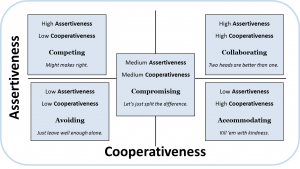Negotiate Smoothly by Understanding Conflict Styles - Part 3
 Using the Thomas-Kilmann Conflict Mode Instrument (TKI) to identify five discrete conflict styles, we started with an overview of the model and styles. In the second post, we looked at the advantages and disadvantages of using Competing and Avoiding styles. Throughout the series, our objectives are to understand our own style preferences, to become more facile with non-preferred styles, and to understand and respond appropriately to our buyers’ preferred styles. This week, we’ll take a closer look at Compromising and Accommodating styles.
Using the Thomas-Kilmann Conflict Mode Instrument (TKI) to identify five discrete conflict styles, we started with an overview of the model and styles. In the second post, we looked at the advantages and disadvantages of using Competing and Avoiding styles. Throughout the series, our objectives are to understand our own style preferences, to become more facile with non-preferred styles, and to understand and respond appropriately to our buyers’ preferred styles. This week, we’ll take a closer look at Compromising and Accommodating styles.
Both Accommodating and Compromising have a positive connotation. We are socialized at an early age to see the value in some situations of accommodating others, even subjugating our needs to meet the needs of others in a selfless way. Compromising is seen as a critical skill in relationships.
Here’s the problem. When you use an Accommodating style, you are putting the needs of others above your own needs. You enter into the negotiation with a high level of cooperativeness and a low level of assertiveness. What this means is that you will not get all of your needs met.
The same is true with a Compromising style. You will give up some of your needs. Equally noteworthy is that your buyer will also give in so that not all of his or her needs are met either. You both lose. Leaving needs unmet is very risky indeed, even when it feels like a mutually satisfactory agreement is reached. Those unmet needs, you see, are the just the open door your competitors need to find their way in to your customers.
There are, of course, times when you should use these two styles. If, for example, you are entering into a negotiation where your buyer has been unsatisfied with you or your company in the past, you may need to use an Accommodating style as a show of good faith reparations.
Compromising is an effective style when you have exhausted your other options for reaching an agreement. Rather than starting with a semi-satisfactory outcome, choose this style later in the negotiation. Offer your compromise as a temporary stopgap to buy time for broadening the discussion and reaching a longer-term solution that is more complete in meeting all the needs on the table.
Many negotiators use an Accommodating style as a way to gain ground and set up an ambush. If you see concessions made early in the negotiation, this could be a red flag. Be careful with accommodations you accept because the time will come when payback is expected. A better strategy is to set aside those offers with a “thank you for offering, but let’s come back to that when we see the whole picture.” Alternately, you can call out the accommodations before accepting them by simply asking “what would you need in exchange for that?”
Similarly, a Compromising style can lead you down a path you don’t really want to travel down. When the other party in the negotiation suggests that you meet in the middle, evaluate what that really means. Can you truly be satisfied with the concessions you’ll make to get to the middle? Will the other party be satisfied long-term with that middle ground? What are the hidden costs of meeting in the middle instead of being the supplier who meets all the needs of this customer?
Here’s a best practice. When it comes to Accommodating and Compromising styles, always pause to ask yourself “Why?” Ask “Why am I going to accommodate or compromise in this situation?” to be sure you don’t move here too quickly. Ask “Why is my buyer accommodating or compromising in this situation?” before accepting what is suggested. This assessment will help you maintain objectivity and a rush to action that could be costly in the long run.
In the next post, we’ll wrap up by taking a close look at the Collaborating style and how to use it to open your negotiations. As you work through this series, be mindful of the style(s) you typically use in conflict or negotiating and begin observing others’ styles, too. Soon you’ll be that seller others envy for your finesse in tough conversations.
This blog post is the third of four in a series on conflict styles and how to use them in negotiating.
To learn more about the TKI Assessment and how it can help you with negotiation and conflict resolution skills, please contact PFPS for coaching and training. You can also access the assessment directly at CPP.

